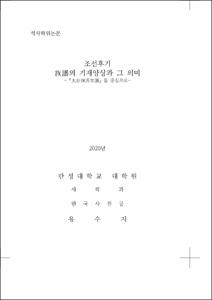조선후기 族譜의 기재양상과 그 의미
= A Study on the Presentation Patterns and Meanings of the Late of Joseon Dynasty Genealogical Table : Focusing on the 『Genealogical Table of the Daegu Seo Family』
- Type
- Thesis
- Alternative Title
- -『大丘徐氏世譜』를 중심으로-
- Department
- 대학원 사학과
- Issued Date
- 2020
- Publisher
- 한성대학교 대학원
- Files in This Item:
-
-
Download
 200000335335.pdf
기타 데이터 / 871.95 kB / Adobe PDF
200000335335.pdf
기타 데이터 / 871.95 kB / Adobe PDF
-
Items in Repository are protected by copyright, with all rights reserved, unless otherwise indicated.